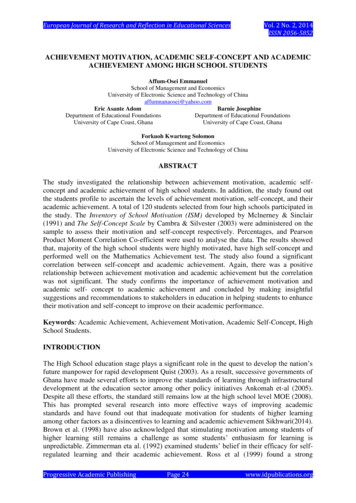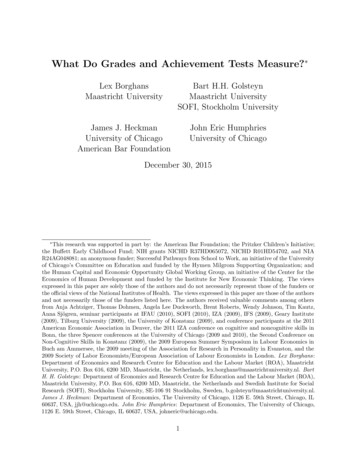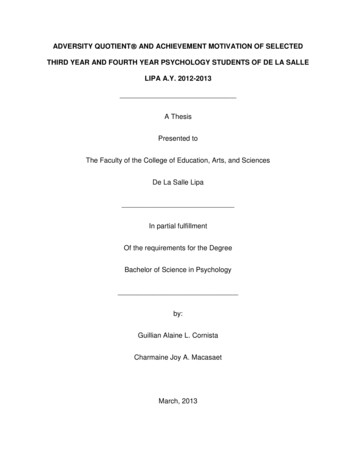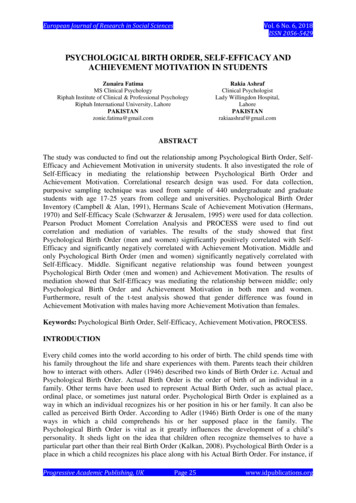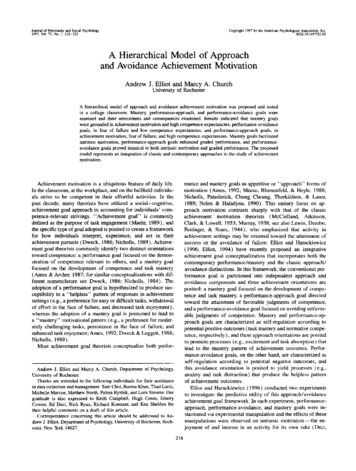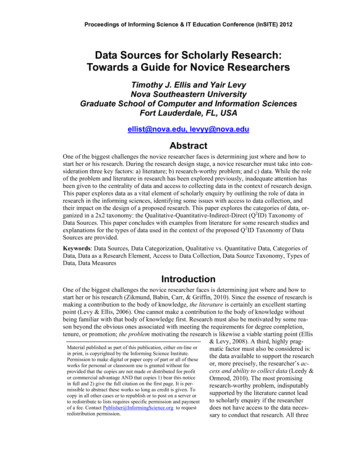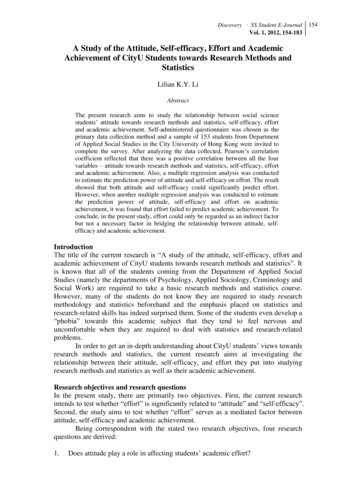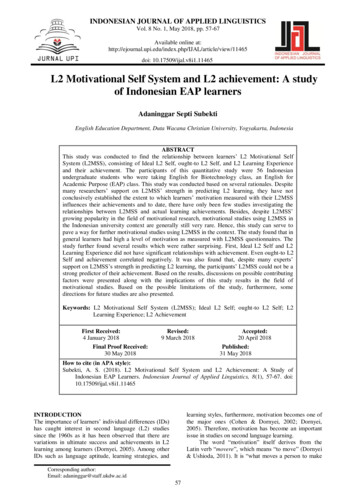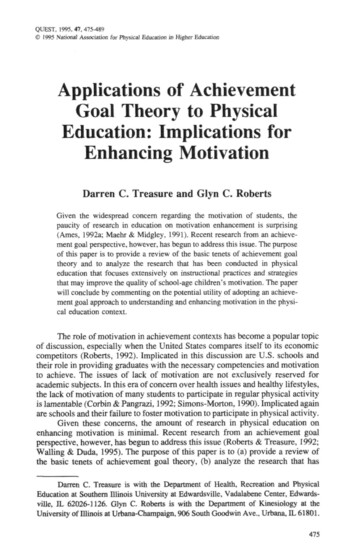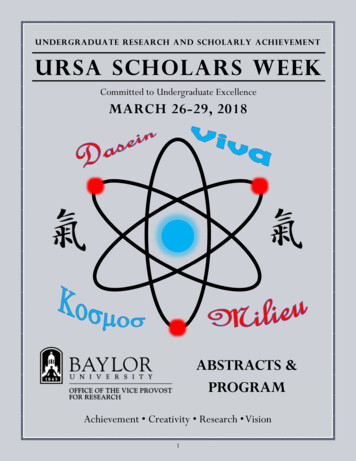
Transcription
UNDERGRADUATE RESEARCH AND SCHOLARLY ACHIEVEMENTURSA SCHOLARS WEEKCommitted to Undergraduate ExcellenceMARCH 26-29, 2018ABSTRACTS &PROGRAMAchievement Creativity Research Vision1
Nominate your faculty researchadvisor forUndergraduate ResearchMentor of the Year!Nomination forms are available on the URSA website:(www.baylor.edu/ursa).It will only take a few minutes to complete a nomination for an exceptional research mentor, and submit itvia the website.2
What is URSA?The Undergraduate Research and Scholarly Achievement (URSA) initiative at Baylor welcomes all undergraduates, fromfreshman to senior, to maximize their education through a variety of research, creative and scholarly activities. Undergraduates take advantage of opportunities on-campus from the laboratories in the Baylor Sciences Building, to the design studios,to the library collections. They also participate in off-campus programs, including research internships at medical schools,assistantships at field stations, and apprenticeships in museums. URSA sponsors a small grant program, with funds availableexclusively for undergraduate projects.What is Scholars Week?Each year Baylor Sponsors a series of events to celebrate undergraduate research and creativity. Every spring, Baylor dedicates an entire week to scholarly presentation. The first two days are dedicated to platform (oral) presentations where students from a cross-section of academic disciplines share their projects and results. In mid-week, individual students and research teams dis-play posters in the Baylor Sciences Building. Academic departments and the Baylor Libraries provide judgesto determine the most outstanding efforts from both the platform and poster presentations. URSA recognizes the winners,along with outstanding faculty mentors at an Awards Reception at the end of April.Who administers Scholars Week and URSA?The Office of the Vice Provost for Research has oversight over The URSA Steering Committee, which includes faculty andstudent representatives. Administrative research staff participate ex-officio. BURST, Baylor Undergraduate Research in Science and Technolgy, a student-run organization, assists with the event venue for Scholars Week.The URSA Steering CommitteeSusan Bratton, PhD, DirectorWilliam Chan (BURST)Dennis Johnston, PhD, Grants ChairCindy Burney, PhDTamarah Adair, PhDPaul Larson, PhDEileen Bentsen, MLSRobert Miner, PhDCourtney Smith (BURST)Kelly Rossler, PhD, RNNathan Elkins, PhDRich Sanker, PhDPatrick Farmer, PhDDianna Vitanza, PhD (OVPR)Jonathan Hu, PhDBrian Raines, PhD3
Colleagues:Once again, I have the pleasure of welcoming you to the Baylor URSAScholars Week. Please find time within your busy schedule to examine thebreadth and depth of the research of our students. It is easy to see that Baylor Research is Making a Difference in the lives of our undergraduates aroundthe world.The achievements of the faculty and students represented in this eleventhannual Scholars Week celebration are exemplary. As such, I encourage youto sample all of the scholarship on display, not just in your own discipline.The quality of each individual presentation once again demonstrates themonumental commitment pro-vided by every Baylor faculty mentor and thedirect impact this commitment has on our students.Please also take the time to thank your faculty colleagues and students whohave worked so hard to bring URSA to where it is today. Their unwaveringenthusiasm promises a bright future for the undergraduate research experience at Baylor and is worthy of our praise!As always, please accept my thanks for all you do on a daily basis for Baylorresearch.I appreciate it and you.Best regards,Truell W. HydeTruell W. Hyde, PhDVice Provost for Research4
KEYNOTE ADDRESSA special Scholars Week presentation and reception, organized as part of the speakers series sponsored by BURST. with The College of Arts and Sciences.Adventures in Solid State Synthesis: Hidden Gems to Link Materials’ PropertiesJulia Chan, PhDAuthor of over 170 publications in solid state chemistryMonday, March 26, 20184:00 pm BSB B110Presented by:Professor Julia Chan (B.S. in Chemistry, Baylor University; Ph.D., University of California at Davis) began her faculty appointment at Louisiana State University in Fall 2000, after spending two years as a National Research Council Postdoctoral Associate at the National Institute of Standards and Technology inthe Materials Science and Engineering Laboratory. She then moved her research group to the Universityof Texas at Dallas Fall 2013. Her research interests involve synthesis of materials that exhibit metal-toinsulator transitions, mixed valence, highly correlated electronic systems, superconductivity, and materials for energy conversion. Efforts are placed on the crystal growth, structures, and properties of new materials. Prof. Chan has published over 170 papers and given over 100 invited talks. She has graduated 19Ph.D. students and has mentored over 40 undergraduates in her laboratory. Prof. Chan’s awards includeNSF Career Award, American Crystallographic Association Margaret C. Etter Early Career Award, BaylorUniversity Outstanding Alumni Award, Alfred P. Sloan Research Fellowship, Iota Sigma Pi Agnes Fay Morgan Award, American Chemical Society Exxon Mobil Faculty Fellowship in Solid State Chemistry and oneof 12 Profiled in 2002 C&E News series on “Women in Chemistry”, highlighting women making an impact in the chemical sciences. She is currently an associate editor of Science Advances and served on the Editorial Advisory Board of Chemistry of Materials and Inorganic Chemistry.5
Table of ContentsOral Presentations– Bill Daniel Student CenterMONDAY1:30 p.m.8MONDAY3:30 p.m.18TUESDAY1:30 p.m.21TUESDAY3:30 p.m.28Poster Presentations– Baylor Science BuildingSession One: Monday—TuesdayFamily and Consumer Science35Pre-Health and Biology36Health, Human Performance and Recreation48Geosciences58Chemistry and Biochemistry63Session Two: Wednesday-ThursdayCommunication Sciences and nmental Science70Psychology & Physics94Engineering986
Platform PresentationsBill DanielStudent CenterMarch 26-27, 20187
Monday, 1:30 p.m. Session One - Baines RoomEconomicsA1. The Effect of the Gender Education Gap on Infant Mortality Rates in Sub-Saharan AfricaJessica Schurz; Faculty Mentor: Dr. Corneliu BolboceanDepartment: EconomicsClosing the gender gap in education has the potential to develop the third world. Investing in education empowers both men and women by creating a healthier and more economically developed population. This paperseeks to explore how the gender education gap affects infant mortality rates in Sub-Saharan Africa. Data fromthe years 2000-2015 across 48 Sub-Saharan African countries was collected from the World Bank data base totest the hypothesis that the education gender gap is an indicator of a country’s infant mortality rate, holdingconstant life expectancy, health expenditure, adolescent fertility rate, GDP, and GDP growth. Evidence wasfound to support this hypothesis, indicating that the gender gap in education has affected infant mortality ratesin Sub-Saharan Africa over the past 16 years. One of the major contributions of this paper is in explaining howthe education gender gap is an indicator (rather than predictor) of health outcomes. Other researchers have explored how women’s empowerment causes health outcomes on a societal level. They argue that women currently enrolled in school are likely to have children later, have fewer children, take better care of their children,and implement better health practices. This paper is unique in that it looks specifically at a population of girlswho are not having children -these girls are not the ones whose infants are dying. This paper shows, rather,that the countries which are not educating women are likely to have worse health outcomes for its infants.A2. Charitable Giving and Its Effects on Altruistic BehaviorRebecca Peirce; Faculty Mentor: Dr. Jason A. AimoneDepartment: EconomicsProsocial behavior, specifically the acts of volunteering and charitable giving, is an aspect of human behaviorthat has been analyzed by economists in the recent past. When the acts of volunteering and contributing tocharity are analyzed at surface level, it appears that those individuals who participate in these actions do so only for the benefit of those less fortunate or for the betterment of society. Research has shown, however, thatone’s desire to volunteer can stem from various motives, one of which is warm glow motivation. Warm glowmotivation is the desire to engage in prosocial behavior not because the prosocial behavior benefits society, butrather because it provides the individual engaging in the prosocial behavior with positive feelings that boostself-image (Lilley and Slonim, 2013). The research conducted in these laboratory experiments further analyzesprosocial behavior in order to draw conclusions regarding charitable giving and the manner in which it affectsan individual’s altruistic behavior. Specifically, the laboratory experiments focus on the ways in which different social settings, including the public knowledge of one’s charitable donations and the presence of a representative from the charitable organization, affect an individual’s altruistic behavior and the motivations underlying this behavior.A3. Identifying Differential Effects of Mass Incarceration on Substance AddictionSamuel Kang; Faculty Mentor: Dr. Scott CunninghamDepartment: EconomicsThe total count of individuals incarcerated in state prisons grew by nearly 250 percent from 1980 to 2000. Thisgrowth may in part be explained by a general tightening in American criminal justice policy, particularly with8
respect to drug enforcement. This paper investigates the effect of rising incarceration rates on state-level ratesof substance abuse across race-gender groups by exploiting a significant overcrowding law suit against theTexas prison system. In the aftermath of the case, Texas over doubled its prison capacity and the state prisonpopulation more than tripled in size. To conduct my analysis, I use two-stage least squares estimators to instrument for Texas incarceration rates with operational prison capacity and discretionary parole rates. My estimates show that Texas drug treatment admissions declined in response to this rise in incarceration and thatthese declines differ across race and gender groups. Black and male drug users, who are known to be moreclosely associated with the contemporary crack epidemic, are shown to be the most responsive to rising incarceration rates. I also find that alcohol treatment admissions decline in response to rising incarceration rates,giving indirect evidence that the reductions in drug admissions are at least partially driven by incapacitationeffects.Monday 1:30 p.m. Session Two - Beckham RoomHistory and GovernanceA4. Epic Poetry or Epic Biography? The History of William Marshal and The Life of the Black Princein the Middle AgesT. C. Kniphfer; Faculty Mentor: Dr. Jeffrey S. HamiltonDepartment: HistoryWilliam Marshal, Earl of Pembroke (c. 1147-1219) and Edward the Black Prince (1330-1376) were both phenomenal soldiers and leaders who so inspired their contemporaries that each man had a biography written notlong after his death. These were The History of William Marshal and The Life of Black Prince. The object ofthis paper is to analyze the comparative natures of the History of William Marshal and The Life of the BlackPrince primarily as they relate to war and the idea of the noble leader. It will demonstrate how the aristocraticmartial culture that surrounded each man was instrumental in producing these two vernacular biographies. Finally, given the political history of the careers of Marshal and the Black Prince, this paper will show the importance of these sources for political historians in the reading of the history of each’s man respective period.A5. Peter Wentworth: Parliamentary Hero or Anti-Monarchist Traitor in Elizabethan England?Kyle Martin; Faculty Mentor: Dr. Bracy Hill IIDepartment: HistoryPeter Wentworth, a puritan MP known for speaking out directly against Queen Elizabeth I, has long beenviewed as indicative of a larger pattern emerging within the parliaments of the queen, namely, a growing beliefin the position of monarchical republicanism. Monarchical Republicanism, a term first coined and defined byPatrick Collinson roughly describes a growing sentiment under Elizabeth I that her counselors, although dedicated servants of the Queen, also bore some separate obligation of service to the state beyond the wishes of theVirgin Queen. Wentworth has been viewed in even stronger terms derived from the foundations of monarchical republicanism, with many English historians viewing him with somewhat anachronistic tendencies, attempting to attach anti-monarchical views to Wentworth that are more fitting in describing Parliamentarians inthe English Civil War than Elizabethan MPs. This flawed approach is exacerbated by Parliamentary “high drama” historiography that tends to examine instances of dramatic political upheaval in Elizabeth’s Parliamentsrather than realistic records of Parliamentary proceedings. An examination of Parliament and Elizabeth’s opinions on Parliamentary counsel and Parliamentary privilege, coupled with a focus on Wentworth’s contentiousspeeches in Parliament and the process of gradual institutional expansion of parliamentary power and privilegereveal Wentworth to not be a symbol of change, but rather an outsider, constantly opposed not only by theQueen but by Parliament, whose vision of a limited monarchy and an expanded and empowered Parliamentwere applicable for an enemy of Charles I, but not for a loyal subject of Queen Elizabeth I.9
A6. Bolivarian Revolution in Retreat: Understanding the Venezuelan Crisis, its Human Toll and its OutlookFernando Centeno; Faculty Mentor: Dr. Sara AlexanderDepartment: AnthropologyFrom 2008 to 2016, the Bolivarian movement of Venezuela, now in its second decade of life, saw the country'seconomy quickly deteriorate as its supporters witnessed the collapse of a governing framework that for longoffered the country's disenfranchised the means to escape long-perpetuated adversity and inequality. The human cost of this crisis has been unparalleled in the bicentennial history of the Latin American nation: risinginfant and maternal mortality, ubiquitous scarcity of food and basic commodities, and repressive efforts by anincreasingly entrenched government have engendered an impoverished and precarious livelihood for the citizens of one of the world's leading oil exporters. Contextualizing these concomitant national maladies, thispresentation aims to (1) examine the social, economic, and political factors that precipitated this apparent vicissitude of fortune, (2) characterize the impact of the crisis on Venezuelan health and society, (3) discuss andanalyze the response from aid agencies and financial entities abroad, and (4) evaluate the prospects of recoveryfor the country and the future of the post-Hugo Chávez Bolivarian national project.Monday 1:30 p.m. Session Three - White RoomA7. The Significance of the Trends Shown in The Austrian Party System Duringthe 1990sLauren Barnes; Mentor: Dr. Ivy HamerlyDepartment: Political ScienceDuring the 1990s, Austria experienced a massive ideological shift toward the right. Studying the ManifestoProject’s database and right-left indicator scores show that parties that had been left leaning for decades weresuddenly adopting right-wing positions. For example, the Greens, a traditionally leftist party, jumped up nearly30 points towards the right from 1990 to 1994. In this analytical paper I seek to answer why the Austrian system as a whole experienced these changes. I argue that this shift was caused because parties shifted their ideologies in an attempt to appeal to the median voter, and could not do so because the Austrian system was experiencing political dealignment. In order to test this theory, this paper looked at the first three elections in the1990s and consistently found signs pointing to dealignment including drops in voter turnout, voter volatility,the formation of splinter parties, and more voters being classified as waverers and later deciders. However, thispaper also tested the conflicting theory of realignment and found there to be no significant correlation betweenwhere a party fell on a postmaterialist indicator, freedom and human rights, and what percent of the vote theparty received. After concluding that the Austrian system was experiencing dealignment not realignment, thispaper then applied the Down’s proximity model to explain how dealignment caused the political system toshift. Finally, I reach the conclusion that because voters felt frustrated with the political status quo that hadprevailed for decades in Austria their voting patterns changed, and then political parties were unable to find themedian voter, so they responded by changing their ideologies in an attempt to recapture the median voter. Thisresearch is significant because if the trends established in the early elections of the 1990s were to continue,however, one could expect to see even more voter volatility and ideological shifts in the parties. Until the voters’ faith in Austrian politics returns and they began to vote predictably, political parties will be unable to accurately find the median voter, and will then, as a result, swing across the ideological spectrum.A8. The Rise in Sentiment Against Immigrants in Germany: Economic Concerns or Something More?Hannah Byrd; Faculty Mentor: Dr. Ivy Hamerly10
Department: Political SciencePoliticians and governments with xenophobic and anti-immigration policies often cite the economic insecuritythat immigrants create to justify these policies. The refugee crisis in Syria and other areas of the Middle Easthas made immigration a particularly salient topic in the western world and especially in the European Union(EU) in recent years. Germany leads the EU in receiving asylum seekers from the crisis and historically has awelcoming culture or willkommenskultur to refugees; it has also experienced a rise in sentiment against immigrants according to the World Values Survey. This paper seeks to find if economic insecurity has caused sentiment against immigrants to rise in Germany. To answer this question, this paper analyzes sentiment towardimmigrants in terms of the percentage of surveyed Germans who indicated that they did not want immigrantsor foreign workers as their neighbors in a World Values Survey question from 1992-2013. This paper analyzesGermans’ economic security in terms of the unemployment rate meant to indicate individual economic wellbeing from 1991-2016 with data from the World Bank. Finding a lack of connection between the two variables, this paper argues that economic concerns cannot account for the rise in sentiment against immigrants inGermany. Upon further analysis, this paper finds that security concerns and dissatisfaction with current policyprovoked the rise in sentiment against immigrants and led some German voters to seek different political solutions in the recent election.A9. Gendered Jailing: Women’s Incarceration on the RiseMackenzie Chakara; Faculty Mentor: Dr. Patrick FlavinDepartment: Political ScienceIn my research, I aim to look at the rapidly increasing rate of women in the United States criminal justice system. While there has been a strong push to reduce the number of male inmates as legislators seek to reverse themass incarceration crisis, women’s incarceration rates are climbing exponentially. I aim to examine the growing rate of female imprisonment, especially seeking a leading cause of the increase. I hypothesize that the emphasis that legislators and criminal justice reform advocates place on reducing male prison populations has ledwomen- many of whom are tied to crimes along with their male partners - to become the new overrepresentedgroup in prisons. To date, the racial disparity among incarcerated women has been steadily decreasing, so itappears that this issue is largely gendered as opposed to the racialized nature of male incarceration. Workingwith Dr. Flavin, I plan to test my hypothesis about criminal justice reform targeting male incarceration in orderto decipher whether these well-intentioned efforts have ultimately led to another humanitarian crisis: the massincarceration of women.A10. Popular or not so Popular? Offensive Structural Realist and Institutionalist Predictions of GermanNeighbors in Regards to German PowerJohn Ryan Isaacson; Faculty Mentor: Dr. Ivy HamerlyDepartment: International StudiesA powerful Germany, both militarily and economically, has not always boded well for the continent of Europe.As of today, Germany has the largest European economy in terms of GDP, it has the largest population, and itis a central player within the European Union. Should Germany’s neighbors hold a favorable view of Germaninfluence, despite its success? This paper will test the explanatory power of two International Relations theories in regards to German popularity within three other states: Great Britain, France, and Spain. The two theories are Offensive Structural Realism, which predicts that Germany’s neighbors should not view German influence as favorable, and Institutionalism, which predicts that institutions like the EU do allow German neighborsto view German influence as favorable. Each theory will have testable independent variables which act on thedependent variable, which is each state’s view of German influence. The dependent variable will be verifiedby a survey conducted by Globescan/BBC/PIPA, which measures the percentage of respondents within Germany, Great Britain, France, and Spain who had a favorable view of German influence in the years of 20082014. This paper concludes by showing that Offensive Structural Realism’s predictions do not hold in Germany today; but rather, the Institutionalist’s predictions do hold. Because of institutional rules and economic in11
terdependence, German neighbors generally have a favorable view of German influence, despite Germany’seconomic power.Monday 1:30 p.m. Session Four - Fentress RoomBiology, Chemistry and StatisticsA11. qRT-PCR analysis of bivalent genes implicated in EMT and their response to KDM6A H3K4me3demethylaseTaylor Nesbit; Faculty Mentor: Dr. Joseph TaubeDepartment: BiologyModifications of histones near promoter gene regions have the capacity to serve as docking sites for eithertranscriptionally-promoting or silencing proteins. Trimethylation of H3K4 near promoters is known to stimulate transcription and trimethylation of H3K27 near promoters is known to repress transcription. Some genespossess both a histone modification that poises for activation and one that poises for inhibition within the samepromoter. A histone demethylase the H3K27me3 mark, KDM6A, is known to participate in the transition to amonovalent methylation state, during retinoic acid-induced differentiation of mouse ES cells. Some genes possess both a histone modification that poises for activation and one that poises for inhibition within the samepromoter; this is referred to as a bivalent domain. We decided to look at regulation of KDM6A through inhibition utilizing the small molecule inhibitor GSK-J4 in known bivalent genes during the progression of epithelial-to-mesenchymal transition (EMT) and mesenchymal-to-epithelial transition (MET). EMT/MET is thought toimplicated in the metastasis of cancer cells. Western blot analysis determined that KDM6A protein is highlyexpressed during MET and its expression decreases during EMT. Through qRT-PCR, we observed the effectsof KDM6A inhibition on a set of known bivalent genes. The bivalent genes were categorized into subsets viathe state of their chromatin configuration before and after EMT. Sets where H3K4me3 is initially present andK27me3 is acquired de novo were characterized as Group I and involved genes involved in cell growth anddifferentiation. Sets where H3K27me3 was initially present and H3K4me3 was acquired after EMT were characterized as Group II. Group III were characterized as having no initial H3K4me3 and H3K27me3 marks andresolving in bivalency, and Group IV were characterized as being bivalent before and after EMT. From analysis of qRT-PCR data, we observed that the majority of genes in Groups I-III are downregulated to a statistically significant degree following TGFB-induced EMT in MCF10A cells. The majority of group IV genes conversely, were unchanged. Overall, this data shows that KDM6A-dependent H3K27me3 removal is involved inthe re-expression of bivalent genes to confer epithelial characteristics following MET. Future investigationsinvolve determining the effectors involved in KDM6A regulation during EMT and MET to determine possibleanti-metastatic targets.A12. High Performance Liquid Chromatography Analysis of the Bioreductive Cleavage of ProdrugKGP372 to Its Effector Anti-cancer Agent Combretastatin A-4Nathanael Lutz, Cody Hamrick, Kadon Caskey, Tracy E. Strecker, Yifan Wang, Matthew T. MacDonough;Faculty Mentors: Dr. Kevin G. Pinney, Dr. Mary Lynn TrawickDepartment of Chemistry and BiochemistryRegions of hypoxia are common in cancerous tumors and contribute to chemotherapeutic treatment failure andcancer metastasis. Cell studies have demonstrated that NADPH cytochrome c P450 oxidoreductase (POR) is amajor enzyme responsible for the activation of the nitrothiophene-containing prodrugs under hypoxic conditions. In cells with standard oxygen levels, any reduced prodrugs are spontaneously re-oxidized. The purposeof this research, collaborative with the Pinney Group at Baylor University, was to analyze the bioreductive12
cleavage of the prodrug KGP372to the active anti-cancer agent combretastatin A-4(CA4) by POR. To ensurehypoxia, the reaction solutions were flushed with nitrogen and incubated with the oxygen scavenging enzymeprotocatechuate-3,4-dioxygenase (PCD)and its substrate protocatechuate (PCA). In addition to POR, PCA andPCD, the reactions contained NADPH, Triton X-100to facilitate solubilization of the prodrug, and KGP372 inphosphate buffer (pH 7.4). Reactions were treated with acetonitrile and analyzed by reversed phase highperformance liquid chromatography (HPLC) using the following mobile phase:55% acetonitrile/water (10min), followed by a gradient (30 min)increasing to 95% acetonitrile/water (10 min). Using this method, CA4and KGP372 standards were eluted from the column with retention times of 6.5 min and 24.0 min, respectively, and detected by absorbance at 254 nm and 300 nm. Standard curves were linear from 2.5-200 μM for bothCA4 and KGP372. Reaction samples were analyzed by this method and demonstrated cleavage of the prodrugto CA4.A13. Structural and Mechanistic Insight of MCMsMichael Bougoulias; Faculty Mentor: Dr. Michael TrakselisDepartment: Chemistry and BiochemistryHelicases are an essential group of enzymes necessary for unwinding duplex DNA. Amongst many types ofhelicases, the Mini Chromosomal Maintenance (MCM) family of proteins plays a central role in DNA replication and repair. While much is known regarding MCM, many structural and mechanistic details currently eludeour knowledge. MCM8 is an important human helicase thought to be involved in double strand (ds) DNAbreak repair pathways and has been associated with infertility and diseases such as premature ovarian failure.[1] As more of the biological role of MCM8 is revealed, there is an increasing demand to unveil the structuraland mechanistic components of this helicase. In this project, the N-terminal segment of MCM8 was purified inorder to raise antibodies against MCM8. These antibodies will accelerate the study of MCM8 with applicationsranging from in vivo MCM8 detection to purification of full length MCM8. In addition, the mechanism ofDNA unwinding was investigated utilizing a structurally homologous Archaeal replicative MCM from Sulfolobus solfataricus (Sso). We are investigating the role of the excluded DNA strand during DNA unwinding. Unwinding assays were performed utilizing forked DNA and morpholino substrates which have different backbone chemistries. Results highlighted the importance of an electrostatic interaction between the excluded DNAstrand and the external surface of SsoMCM, which support the Steric Exclusion and Wrapping (SEW) modelfor helicase unwinding.Monday 1:30 p.m. Session Five - Houston RoomHealth, Environmental and GeosciencesA14. The Impact of Health Literacy on Health Behaviors of Waco ResidentsAlexa Larsen; Faculty Mentor: Dr. Beth LanningDepartment: Public Health (Health, Human Performance, and Recreation)Literacy, especially health literacy, is lacking in the U.S. adult population, especially among people of low socioeconomic status. According to the 2003 National Assessment of Adult literacy, 36% of adults have belowaverage competence in interpreting and acting upon health information. Low health literacy has been linked topoor patient outcomes and higher rates of negative health behaviors, but results of studies examining the association of health literacy with smoking and drinking behaviors have been mixed. Furthermore, few, if any,studies have investigated the relationship of health literacy with health anxiety. In this study, we measuredhealth literacy among adults at the Waco Family Health Center using the Newest Vital Sign tool. Smoking anddrinking behaviors were gathered from EPIC medical records as reported by patients to their primary care physician. Health anxiety was tested using a shortened Whiteley Index. The data were then analyzed for correlations between health literacy and each variable separately, controlling for demographic fa
The achievements of the faculty and students represented in this eleventh annual Scholars Week celebration are exemplary. As such, I encourage you . Her research interests involve synthesis of materials that exhibit metal-to-insulator transitions, mixed valence, highly correlated electronic systems, superconductivity, and materi-
